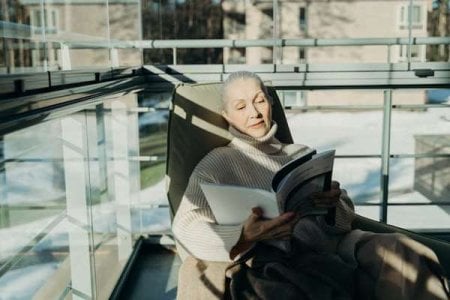Slash Your Heating Bills This Winter With These Genius Eco-Friendly Warming Hacks!
By
Danielle F.
- Replies 0
Winter in Australia can be a bit of a shock to the system—especially if you’re used to balmy days and sunshine! For many of us, the colder months mean waking up to frosty windows, layering up like we’re heading to the Arctic, and keeping a doona permanently stationed on the couch. But as the mercury drops, the cost of keeping warm can skyrocket, leaving us with eye-watering energy bills and a guilty conscience about our carbon footprint.
But what if you could stay toasty this winter without breaking the bank—or the planet? Here at the Seniors Discount Club, we’ve rounded up the smartest, most wallet-friendly, and eco-conscious ways to keep the chill at bay. Whether you’re a homeowner or a renter, there’s something here for everyone!
Ditch the Gas—Embrace Efficient Electric Heating
Let’s start with the big one: heating. According to the Institute for Energy Economics and Financial Analysis (IEEFA), the single best move you can make for your comfort and your wallet is to switch from gas to efficient electric appliances. Their latest research shows that a typical Melbourne household could save over $1,300 a year just by making the switch!
Why? Because modern electric appliances—especially reverse-cycle air conditioners—are far more efficient than their gas-guzzling counterparts. Tim Forcey, author of My Efficient Electric Home Handbook, says that heating with a reverse-cycle air-con can cost as little as a third of what you’d pay for gas heating. And if you’re worried about the stigma of using air-con in winter, don’t be! The technology has come a long way, and it’s now one of the most sustainable and cost-effective ways to heat your home.
Jay Gordon from IEEFA adds that a reverse-cycle air conditioner uses about a fifth of the energy of a traditional ducted heater. Plus, if you swap out your gas hot water system for a heat pump, you’ll save even more—both on running costs and by ditching those pesky fixed gas network charges (which can be over $300 a year!).

Don’t Throw Out the Oil Heater Just Yet
While reverse-cycle air-cons are the gold standard, there’s still a place for trusty old oil and electric heaters—especially in small spaces. If you’re working from home or just want to warm up your toes under the desk, a portable heater can be a lifesaver. Just remember: these heaters work like a toaster, so keep an eye on your usage to avoid a nasty surprise when the bill arrives. Many models now come with timers and thermostats, so you can set and forget without wasting energy.
DIY Tricks to Keep the Warmth In
Let’s face it: a lot of Aussie homes are about as well-insulated as a tent. But you don’t need to spend a fortune to make a big difference! Here are some simple, low-cost ways to keep the heat where it belongs:
Draught stoppers: Block those chilly breezes sneaking in under doors and windows.
Seal the gaps: Use weatherstripping or gap filler to plug holes around windows, skirting boards, and vents.
Heavy curtains: Thick, lined curtains can make a world of difference—just remember to close them as soon as the sun goes down.
Rugs and carpets: Bare floorboards look lovely, but they’re not great for warmth. Throw down a rug or two to keep your toes cosy.
If you’re ready to invest a little more, consider double-glazing your windows or upgrading your ceiling insulation. These improvements can slash your energy use and pay for themselves over time.
Get Smart About Your Energy Use
Ever wondered where all your electricity is going? A smart meter can help you track your usage in real time, so you can spot energy-hungry appliances and adjust your habits. Some energy providers even let you monitor your usage from your phone or computer—no more estimated bills or nasty surprises!
Harness the Power of the Sun
If you’re renting or on a tight budget, don’t worry—there are still plenty of ways to stay warm without spending a fortune. One of the simplest is to make the most of the sun. Spend time in rooms that get the most sunlight during the day, and open the curtains wide to let the warmth in. At night, close everything up tight to trap the heat.
And if double-glazing is out of reach, try this old-school hack: stick bubble wrap to your windows in winter. It’s not glamorous, but it does help insulate your home and keep the cold out.
Layer Up and Get Cosy
Sometimes, the best solutions are the simplest. Pull on your thickest socks (bonus points if they’re hand-knitted by Mum!), layer up with jumpers and scarves, and snuggle under a blanket with a hot cuppa. And let’s not forget the ultimate winter warmer—a cuddle with a loved one or a furry friend. No government rebate required!
Staying warm this winter doesn’t have to mean sky-high bills or a guilty conscience. With a few smart choices and some old-fashioned ingenuity, you can keep cosy, save money, and do your bit for the planet.

Have you discovered any clever ways to stay warm without blowing the budget? Do you swear by a particular heater, or have you tried any of these tips? Share your stories and advice in the comments below—we’d love to hear from you!
MORE WINTER TIPS: Discover the housekeeper's secret from a five-star hotel to make your home perfectly cosy this winter!
But what if you could stay toasty this winter without breaking the bank—or the planet? Here at the Seniors Discount Club, we’ve rounded up the smartest, most wallet-friendly, and eco-conscious ways to keep the chill at bay. Whether you’re a homeowner or a renter, there’s something here for everyone!
Ditch the Gas—Embrace Efficient Electric Heating
Let’s start with the big one: heating. According to the Institute for Energy Economics and Financial Analysis (IEEFA), the single best move you can make for your comfort and your wallet is to switch from gas to efficient electric appliances. Their latest research shows that a typical Melbourne household could save over $1,300 a year just by making the switch!
Why? Because modern electric appliances—especially reverse-cycle air conditioners—are far more efficient than their gas-guzzling counterparts. Tim Forcey, author of My Efficient Electric Home Handbook, says that heating with a reverse-cycle air-con can cost as little as a third of what you’d pay for gas heating. And if you’re worried about the stigma of using air-con in winter, don’t be! The technology has come a long way, and it’s now one of the most sustainable and cost-effective ways to heat your home.
Jay Gordon from IEEFA adds that a reverse-cycle air conditioner uses about a fifth of the energy of a traditional ducted heater. Plus, if you swap out your gas hot water system for a heat pump, you’ll save even more—both on running costs and by ditching those pesky fixed gas network charges (which can be over $300 a year!).
Tip
Hot Tip: Many states are now offering generous rebates for upgrading to electric appliances. In Victoria, for example, it’s often cheaper to replace a broken gas heater with a new electric one, thanks to these incentives. Check what’s available in your area—you might be surprised at how affordable an upgrade can be!
Don’t Throw Out the Oil Heater Just Yet
While reverse-cycle air-cons are the gold standard, there’s still a place for trusty old oil and electric heaters—especially in small spaces. If you’re working from home or just want to warm up your toes under the desk, a portable heater can be a lifesaver. Just remember: these heaters work like a toaster, so keep an eye on your usage to avoid a nasty surprise when the bill arrives. Many models now come with timers and thermostats, so you can set and forget without wasting energy.
DIY Tricks to Keep the Warmth In
Let’s face it: a lot of Aussie homes are about as well-insulated as a tent. But you don’t need to spend a fortune to make a big difference! Here are some simple, low-cost ways to keep the heat where it belongs:
Draught stoppers: Block those chilly breezes sneaking in under doors and windows.
Seal the gaps: Use weatherstripping or gap filler to plug holes around windows, skirting boards, and vents.
Heavy curtains: Thick, lined curtains can make a world of difference—just remember to close them as soon as the sun goes down.
Rugs and carpets: Bare floorboards look lovely, but they’re not great for warmth. Throw down a rug or two to keep your toes cosy.
If you’re ready to invest a little more, consider double-glazing your windows or upgrading your ceiling insulation. These improvements can slash your energy use and pay for themselves over time.
Get Smart About Your Energy Use
Ever wondered where all your electricity is going? A smart meter can help you track your usage in real time, so you can spot energy-hungry appliances and adjust your habits. Some energy providers even let you monitor your usage from your phone or computer—no more estimated bills or nasty surprises!
Harness the Power of the Sun
If you’re renting or on a tight budget, don’t worry—there are still plenty of ways to stay warm without spending a fortune. One of the simplest is to make the most of the sun. Spend time in rooms that get the most sunlight during the day, and open the curtains wide to let the warmth in. At night, close everything up tight to trap the heat.
And if double-glazing is out of reach, try this old-school hack: stick bubble wrap to your windows in winter. It’s not glamorous, but it does help insulate your home and keep the cold out.
Layer Up and Get Cosy
Sometimes, the best solutions are the simplest. Pull on your thickest socks (bonus points if they’re hand-knitted by Mum!), layer up with jumpers and scarves, and snuggle under a blanket with a hot cuppa. And let’s not forget the ultimate winter warmer—a cuddle with a loved one or a furry friend. No government rebate required!
Staying warm this winter doesn’t have to mean sky-high bills or a guilty conscience. With a few smart choices and some old-fashioned ingenuity, you can keep cosy, save money, and do your bit for the planet.
Key Takeaways
- Switching from gas to efficient electric appliances, like reverse-cycle air conditioners and heat pump hot water systems, can save typical Melbourne households over $1,300 a year and significantly lower carbon emissions.
- Electric and oil heaters can still be useful for heating small spaces, but it’s important to monitor their energy usage to avoid unexpected increases in power bills.
- Simple, low-cost improvements such as draught stoppers, sealing gaps, and using heavy curtains can make older Aussie homes much warmer and more energy efficient during winter; bigger upgrades like double-glazing and better insulation have an even greater impact.
- If major upgrades aren’t possible, making the most of sunlight, covering windows with bubble wrap, and wearing warm clothing indoors are effective, budget-friendly ways to stay comfortable as the temperatures drop.
MORE WINTER TIPS: Discover the housekeeper's secret from a five-star hotel to make your home perfectly cosy this winter!








